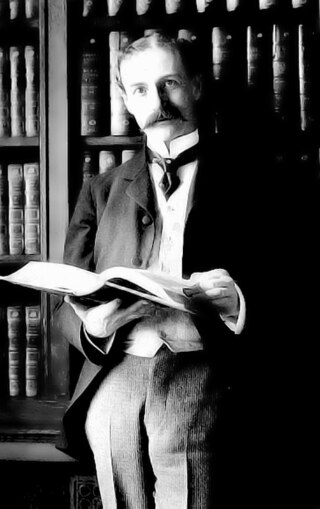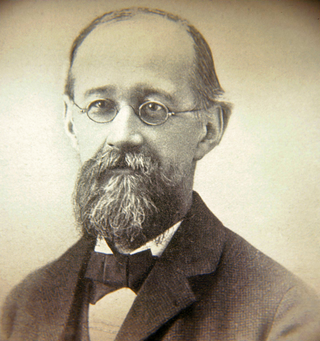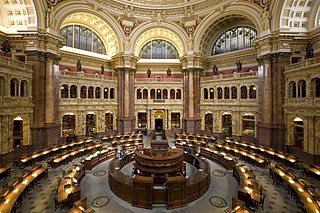Related Research Articles
The Library of Congress Classification (LCC) is a system of library classification developed by the Library of Congress in the United States, which can be used for shelving books in a library. LCC is mainly used by large research and academic libraries, while most public libraries and small academic libraries used the Dewey Decimal Classification system. The classification was developed by James Hanson, with assistance from Charles Martel, in 1897, while they were working at the Library of Congress. It was designed specifically for the purposes and collection of the Library of Congress to replace the fixed location system developed by Thomas Jefferson.

George Herbert Putnam was an American librarian. He was the eighth Librarian of Congress from 1899 to 1939. He implemented his vision of a universal collection with strengths in many languages, especially from Europe and Latin America.

Charles Ammi Cutter was an American librarian. In the 1850s and 1860s he assisted with the re-cataloging of the Harvard College library, producing America's first public card catalog. The card system proved more flexible for librarians and far more useful to patrons than the old method of entering titles in chronological order in large books. In 1868 he joined the Boston Athenaeum, making its card catalog an international model. Cutter promoted centralized cataloging of books, which became the standard practice at the Library of Congress. He was elected to leadership positions in numerous library organizations at the local and national level. Cutter is remembered for the Cutter Expansive Classification, his system of giving standardized classification numbers to each book, and arranging them on shelves by that number so that books on similar topics would be shelved together.
Sanford Berman is a librarian. He is known for radicalism, promoting alternative viewpoints in librarianship, and acting as a proactive information conduit to other librarians around the world. His vehicles of influence include public speaking, voluminous correspondence, and unsolicited "care packages" delivered via the U.S. Postal Service. Will Manley, columnist for the American Library Association (ALA) publication, American Libraries, has praised Berman: "He makes you proud to be a librarian."

The Minneapolis Public Library (MPL) was a library system that served the residents of Minneapolis, Minnesota in the United States. It was founded in 1885 with the establishment of the Minneapolis Library Board by an amendment to the Minneapolis City Charter. Lumber baron and philanthropist T. B. Walker and other city leaders such as Thomas Lowry were members of the first library board. In 2008, after some financial difficulties, the library was merged into the Hennepin County Library system. At the time of its merger, the library included Central Library in downtown Minneapolis and fourteen branch libraries. Its collection numbered about 3.1 million items with about 2.2 million of these housed in the central library.

Gratia Alta Countryman was a nationally-known librarian who led the Minneapolis Public Library from 1904 to 1936. She was the daughter of immigrant farmers Alta and Levi Countryman. She pioneered many ways to make the library more accessible and user-friendly to all of the city's residents, regardless of age or economic position. Countryman was called the "first lady of Minneapolis" and the "Jane Addams of the libraries".

The Hennepin County Law Library is a law library located in Minneapolis, Minnesota, founded in 1883.

Hennepin County Library is a public library system serving Hennepin County, Minnesota, US. The current iteration of Hennepin County Library was formed by the merger of urban Minneapolis Public Library and suburban Hennepin County Library on January 1, 2008. The system has 41 library locations, deposit collections at nursing homes and correctional facilities, mail service to the homebound, and extensive outreach services. The library is a department of Hennepin County Government. The library headquarters are in the Ridgedale Library in suburban Minnetonka. The library system has an eleven-member advisory Library Board appointed by the Hennepin County Board of Commissioners. It is a member of the Metropolitan Library Service Agency, a consortium of eight Twin Cities library systems.

Roosevelt Library is one of 41 community libraries in the Hennepin County Library System, originally part of the Minneapolis Public Library System as it is located in Minneapolis, Minnesota, United States.

Sumner Library is a neighborhood library located in the Near-north neighborhood of Minneapolis, Minnesota, United States. Originally part of the Minneapolis Public Library, it became part of the merged Hennepin County Library in 2008. The Carnegie Library was a haven for Jewish immigrants to the city in the early 20th century. The Minneapolis Public Library moved its entire collection of Yiddish and Hebrew works to the branch library in response to a survey showing that 95% of the patrons were Jewish immigrants, some of whom learned English there and participated in social clubs in the building. The Tudor Revival building is listed on the National Register of Historic Places.

The Library of Congress (LOC) is a research library in Washington, D.C., that serves as the library of the U.S. Congress and the de facto national library of the United States. Founded in 1800, the library is the United States's oldest federal cultural institution. The Library is housed in three elaborate buildings on Capitol Hill. It also maintains a conservation center in Culpeper, Virginia. The library's functions are overseen by the Librarian of Congress, and its buildings are maintained by the Architect of the Capitol. The Library of Congress is one of the two largest libraries in the world, along with the British Library. Its collections contain approximately 173 million items, and it has more than 3,000 employees. Its "collections are universal, not limited by subject, format, or national boundary, and include research materials from all parts of the world and in more than 470 languages."

Walker Library is a public library in the East Isles neighborhood of Minneapolis, Minnesota, United States. It is on Hennepin Avenue one block north of Lake Street, adjoining the Midtown Greenway.

Charles Martel was an American librarian responsible for the creation of the Library of Congress Classification; he is often considered to be one of the most influential librarians in American library history.

Northeast Library is a public library in Minneapolis, Minnesota, United States. It is part of the Hennepin County Library system. Since opening in 1973, Northeast Library at 2200 Central Avenue Northeast in Minneapolis serves a vibrant metropolitan community, Northeast, Minneapolis. At 15,275 square feet, the space held about 30,000 books and featured a fireplace to welcome patrons in winter. The 1973 building was itself a replacement for a Carnegie library which was on the site from 1915 until 1972.

Library service to the Hopkins, Minnesota community was established more than 100 years ago, when the library was housed in City Hall. The library moved to the historic Dow House in 1948 and then temporarily to a vacant restaurant in 1963. The library opened in its current location in 1968 and was renovated in 2002. The library joined Hennepin County Library in 1973.

Edina Library is a branch of Hennepin County Library serving Edina, Minnesota, United States.

William Coolidge Lane was an American librarian and historian. He served for over 45 years in the Harvard Library at Harvard University in Cambridge, Massachusetts.
References
- 1 2 Andy Sturdevant. "Cracking the spine on Hennepin County Library's many hidden charms". MinnPost , 02/05/14.